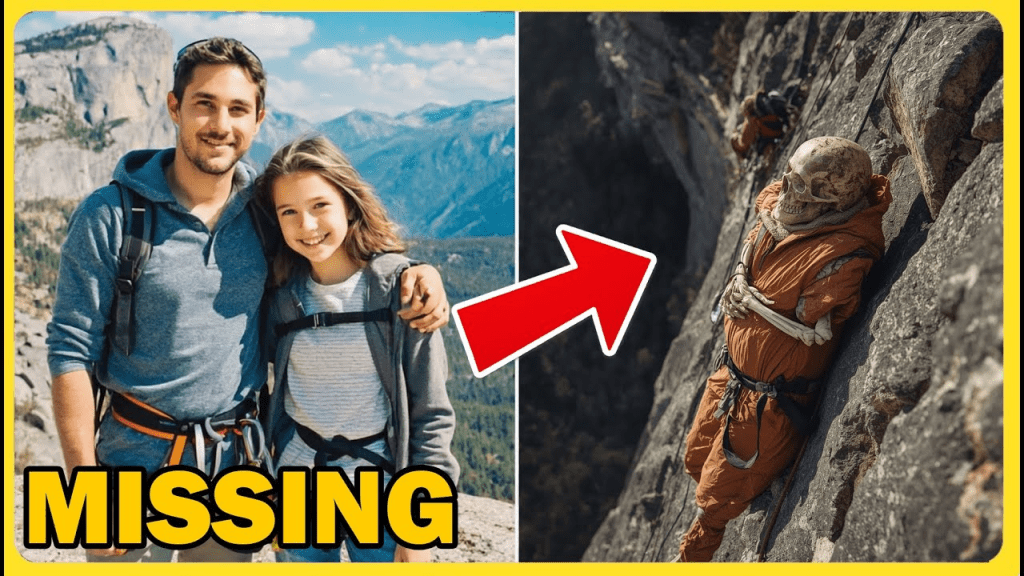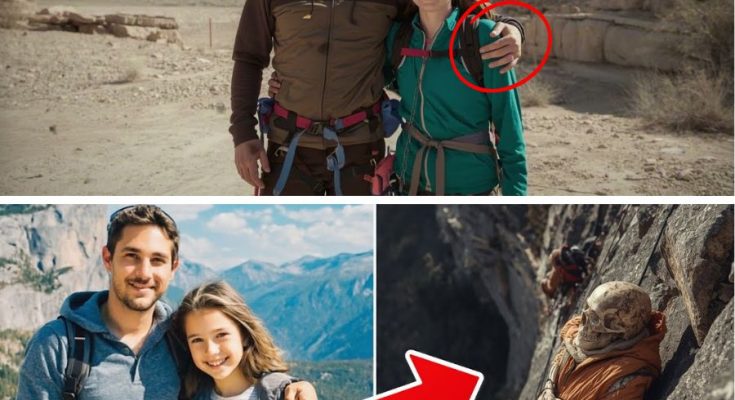Sometimes the mountain doesn’t take lives with a roar of wind and a crash of rock. It just swallows them whole, leaving behind a silence so vast it feels like it will last forever. For 11 years, the disappearance of Colin and Riley Beckwith on Wyoming’s unforgiving Mount Hooker was just such a silence. Their story became a ghost in the high alpine air, a haunting tale that baffled search teams and tore a family apart. But a recent, miraculous discovery has finally laid that ghost to rest, unearthing a truth more powerful and heartbreaking than anyone could have imagined. This is the story of two climbers, a devoted father and his daring daughter, and the final, beautiful secret they left behind.
Video Player is loading.
Current Time 0:00
Duration 0:40
Loaded: 100.00%
Remaining Time 0:40
In late August 2013, Colin Beckwith, a 45-year-old structural engineer, and his 19-year-old daughter, Riley, set out for a trip that was more than just a climb; it was a rite of passage. Colin was a man of meticulous precision, a planner who left nothing to chance. He had summited Mount Hooker before, but this time was different. This was his first major expedition with Riley, a skilled and audacious climber in her own right. For them, the trip was a final summer adventure, a last chance to bond before Riley headed back to college. Everything was planned down to the minute, including a specific check-in time with Colin’s wife, Heather. When that time came and went without a call, a knot of dread began to form in Heather’s stomach.
The fear became a full-blown emergency when Deputy Miles Corbin of the Fremont County Sheriff’s Office drove up to the trailhead. The Beckwiths’ dark green Ford F-150 was there, parked neatly as if they would return at any moment. But a chilling discovery inside the glove compartment changed everything: two fully charged satellite phones, the only lifeline out of the vast Wind River wilderness. Colin, the man who double-checked every knot and calculated every risk, wouldn’t have left these behind. The missing person’s report was upgraded to a full-scale search. Helicopters, ground teams, and volunteers scoured the brutal terrain, but after 10 fruitless days, an early season storm swept in, burying the higher elevations under a blanket of sleet and snow. The search was called off. The Beckwiths had simply vanished.
As the years stretched on, hope grew cold. Riley’s room remained untouched, a museum of a life cut short. Colin’s tools hung neatly in his workshop, gathering dust. The two satellite phones sat in an evidence box, their batteries long dead. In 2016, a small clue surfaced—a climbing nut matching Colin’s gear was found in a remote creek—but without a serial number, the lead went cold. Then, in 2020, a vicious rumor exploded online. An anonymous poster claimed Colin had been in financial trouble and had staged their disappearance to escape his debts, going so far as to harm his own daughter. The theory, though baseless, went viral, inflicting another round of pain on the grieving Heather. The truth of what happened was lost, buried not only by the mountain’s secrets but by human cruelty.

The breakthrough came in 2024, 11 years after the fateful climb, not from an official search team but from two young, elite climbers named Ava Monroe and Liam Bishop. They weren’t looking for answers; they were looking for a challenge, charting a new, unexplored route on Mount Hooker’s face. Days into their ascent, they spotted something odd: a rusted bolt drilled into the granite where no recorded climb existed. Following the strange line of bolts led them to a hidden, shadowed alcove thousands of feet above the ground. Inside, they found a suspended, weathered “portal ledge” where a sleeping bag and a few items of old gear were stored. And then, the discovery that would shake them to their core: a human skull.
With trembling hands, Ava called 911. The photos she sent back were grainy, but the details were undeniable—faded red nylon, a worn carabiner with faint initials scratched into the metal. A specialized rescue crew was dispatched, rappelling down the sheer cliff face to recover what was left. Inside the sleeping bag, partially preserved by the cold, were the remains of Colin Beckwith. But there was no sign of Riley. Had she fallen? Escaped? Was she still alive? Heather dared to ask the question she had held onto for over a decade.
The answers began to surface from a waterlogged journal found in a crushed red dry sack. It was Colin’s field notes, filled with sketches and weather observations, but the last few entries were chilling. He wrote of an unexpected storm, a loose bolt, and rations running low. Then, on August 24, 2013, came the line that would stun everyone: “Riley left this morning. Said she’d go for help. I stayed. My knee can’t move.”
A new search was immediately launched, this time focusing on the little-known “southern bypass” route that Colin had taken. Two days into the search, a ranger found a rusted titanium bracelet tangled in mountain laurel, engraved with the words, “Colin & Riley, Hooker 2013.” The discovery confirmed that Riley had indeed attempted the perilous descent. It narrowed the search to a single ridge line. There, at the bottom of a narrow chute, buried under a slab of granite, was the unthinkable. Another body.
It took six hours to safely excavate the area. When they finally lifted the slab, they found Riley’s skeletal remains, partially protected by the stone. Next to her was a small pack, its fabric frayed but intact. Inside, a compass, two energy bars, and a notebook. It was Riley’s journal. Her words mirrored her father’s early notes, but the tone shifted dramatically after August 24. Her last entries were a desperate testament to her courage. “Dad’s not doing well. His knee is worse. I’m scared to leave him. But he says I have to… I saw the lake. I was close. I know I was close, but I slipped.” The writing became more jagged, the final entry without a date, just one line: “Dad, I made it farther than we thought.” She had descended nearly 2,000 feet, navigating sheer drops with a broken ankle, and had made it to within just two miles of the trail before succumbing to the cold.
When the news broke, it ignited a firestorm of emotion online. The mountaineering community mourned, but the world was struck by the raw courage of a 19-year-old girl who refused to surrender. Colin’s and Riley’s journals were eventually published, their final words becoming a symbol of strength and endurance.

The final piece of the puzzle came from the climbers who discovered them. Ava Monroe and Liam Bishop returned to the ledge in 2025 to pay their respects. As they retraced their steps, they found something they had missed the first time: a faint inscription carved into the rock near the ledge. Three words, scratched almost invisibly into the stone: “We stayed together.” Experts believe Riley carved the message just before she left her father, a final note to the world in case they were never found. It wasn’t poetic or dramatic; it was a simple, powerful truth.
In the aftermath, Wyoming’s backcountry search and rescue protocols were quietly rewritten, and new AI-based mapping systems were deployed. The state went public with an apology to the Beckwith family, but Heather wanted more than blame; she wanted change. She got it. Mount Hooker now bears a plaque near the trailhead in memory of Colin and Riley. Their journals are used as study material for young climbers, lessons in caution, preparation, and the unbreakable bonds of family. A small nonprofit, “The Ledge Project,” was founded in Riley’s name, offering gear and mentorship to girls entering outdoor sports. Heather Beckwith serves on its board. She says she feels peace now. They didn’t die because they were reckless. They died because they were human, and the mountain is unforgiving. But they didn’t go out alone, and they never gave up.



